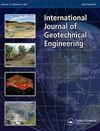Unsaturated soil mechanics with probability and statistics
IF 1.3
Q2 ENGINEERING, GEOLOGICAL
International Journal of Geotechnical Engineering
Pub Date : 2022-04-26
DOI:10.1080/19386362.2022.2069375
引用次数: 0
Abstract
The book, Unsaturated Soil Mechanics with Probability and Statistics, is a crisp distillation of Prof. Kitamura’s lifelong research on unsaturated soils. Co-authored with his former doctoral student, Kazunari Sako, they managed to condense more than 40 years of research work into a book of about 170 pages. The book is divided into 11 chapters. A brief background on the development of classical and unsaturated soil mechanics, and a summary of the book are given in the introduction. The authors pointed out that the approach adopted in the book is an extension of the approaches of Mogami (1965, 1967) and Murayama (1964, 1990). More specifically, probability theory was used to deal with the change in particulate soil structure of coarse-grained soil instead of the usual continuum mechanics. Having set the book in perspective, a review of probability theory and statistics is provided in Chapter 2. This is a very useful chapter as the relevant probability theory and statistics are introduced to ease the reader into the mathematics that are found throughout the rest of the book. Chapter 3 gives a brief account of the macroscopic physical quantities of soils and then starts to build microscopic models using probability distribution to give the particulate soil structure and pore structure in soil. Chapter 4 then looks at how the microscopic physical quantities of number of particles per unit volume, characteristic length, number of contact points per unit volume and unit area, and demonstrates how these microscopic quantities are calculated for simple cubic packing of spheres. The forces and stresses at the contact point between soil particles are described in Chapter 5. Seepage and capillary rise are also described in Chapter 5. Chapter 6 introduces the concept of elementary particulate model (EPM) to model the pore water retention. The explanation of the ink-bottle model schematically and mathematically provides an interesting alternate view of hysteresis in the soil-water retention curve. Chapter 7 derives the unsaturated and saturated coefficients of permeability using the EPM and pore size distribution. Chapter 8 provides some guidance for obtaining friction angle, shear stress on the potential slip plane, apparent cohesion due to suction and a self-weight retaining height using the concepts presented in the earlier chapters. This is then followed by some brief description of their applications to bearing capacity, earth pressure and slope stability. Chapter 9 looks at the deformation behaviour from the microscopic model’s view. This chapter proves challenging to read as it suggests that during deformation the angles at the contact points may change, appear, and disappear. This is then extended to the potential slip plane to estimate the change in contact angle with the change in stress state during deformation using probability theory (Markov process). Chapter 10 illustrates how soil-water characteristic curves, self-weight retaining height and permeability function can be numerically modelled using the microscopic physical quantities. Finally, in Chapter 11, the limitations of the proposed model are summarized and provides suggestions of how they may be overcome in future. Overall, the book is useful to postgraduate students and researchers who like to learn or apply the particle mechanics approach to soil mechanics. The book is not cluttered with too much mathematical details and provides sufficient guidance for the reader to start working on it. Particularly useful is the illustration of how the microscopic physical quantities can be related to the macroscopic physical quantities and to common problems in geotechnical engineering so that a quantum leap is not needed to apply the approach. There are some parts of the book that I found less satisfying. One is the assumption that the inter-particle forces consist of that due to self-weight, capillary, seepage, external, osmotic pressure and physicochemical action, and the elimination of the interparticle forces due to osmotic pressure and physicochemical action. The authors could have provided a more complete explanation of the interparticle forces and the basis for elimination of the interparticle forces due to osmotic pressure and physicochemical action. Second is on the concept of self-weight retaining height where there is no equivalent counterpart in classical soil mechanics. The significance of this concept is unclear. Lastly, the numerical simulations for saturated and unsaturated soil tests in Chapter 10 only show comparison of the numerical results and experimental data for Shirasu’s soil-water characteristic curve and permeability function. It would have been more convincing if other common sands and other tests with similarly good agreement are also illustrated. However, it must be emphasized that Unsaturated Soil Mechanics with Probability and Statistics is a theoretical book that presents an approach to model the behaviour of unsaturated coarse-grained soil. There are several aspects that are left for the readers to explore as explained by the authors in the last chapter of the book.概率统计的非饱和土力学
《概率与统计学的非饱和土力学》一书是北村教授毕生研究非饱和土的结晶。他们与他的前博士生Kazunari Sako合著,将40多年的研究工作浓缩成一本约170页的书。这本书分为11章。引言部分简要介绍了经典土力学和非饱和土力学的发展背景,并对本书进行了总结。作者指出,书中采用的方法是Mogami(19651967)和Murayama(19641990)方法的延伸。更具体地说,概率论被用来处理粗粒土颗粒土结构的变化,而不是通常的连续体力学。在正确看待这本书之后,第二章对概率论和统计学进行了回顾。这是一个非常有用的章节,因为引入了相关的概率论和统计学,让读者轻松了解本书其余部分的数学知识。第三章简要介绍了土壤的宏观物理量,然后开始利用概率分布建立微观模型,给出土壤中的颗粒土结构和孔隙结构。然后,第4章研究了单位体积颗粒数、特征长度、单位体积和单位面积接触点数的微观物理量,并演示了如何计算球体的简单立方堆积的这些微观量。第5章描述了土壤颗粒接触点处的力和应力。渗流和毛细上升也在第5章中进行了描述。第6章介绍了基本颗粒模型(EPM)的概念,用于模拟孔隙水保持率。对墨水瓶模型的示意性和数学解释提供了土壤保水曲线滞后的有趣的替代观点。第7章利用EPM和孔径分布推导出非饱和和饱和渗透系数。第8章为使用前几章中提出的概念获得摩擦角、潜在滑动面上的剪切应力、吸力引起的表观内聚力和自重保持高度提供了一些指导。然后简要介绍了它们在承载力、土压力和边坡稳定性方面的应用。第9章从微观模型的角度研究变形行为。这一章很难阅读,因为它表明在变形过程中,接触点的角度可能会改变、出现和消失。然后将其扩展到潜在滑动平面,以使用概率论(马尔可夫过程)估计变形过程中接触角随应力状态变化的变化。第10章说明了如何使用微观物理量对土壤水分特征曲线、自重保持高度和渗透函数进行数值模拟。最后,在第11章中,总结了所提出的模型的局限性,并就未来如何克服这些局限性提出了建议。总的来说,这本书对喜欢学习或应用颗粒力学方法研究土壤力学的研究生和研究人员很有用。这本书没有太多的数学细节,并为读者开始研究它提供了足够的指导。特别有用的是说明了微观物理量如何与宏观物理量以及岩土工程中的常见问题相关联,这样就不需要进行量子跳跃来应用该方法。这本书的某些部分我觉得不太令人满意。一种是假设颗粒间作用力由自重、毛细管、渗流、外部、渗透压和物理化学作用引起的作用力组成,以及由渗透压和理化作用引起的颗粒间作用力的消除。作者本可以对颗粒间作用力提供更完整的解释,并为消除渗透压和物理化学作用引起的颗粒间作用力奠定基础。其次是自重保持高度的概念,在经典土壤力学中没有等效的自重保持高度。这一概念的意义尚不清楚。最后,第10章中饱和和非饱和土壤试验的数值模拟仅显示了Shirasu土壤水分特征曲线和渗透函数的数值结果与实验数据的比较。如果还说明其他常见的沙子和其他具有类似良好一致性的测试,这将更有说服力。
本文章由计算机程序翻译,如有差异,请以英文原文为准。
求助全文
约1分钟内获得全文
求助全文
来源期刊

International Journal of Geotechnical Engineering
ENGINEERING, GEOLOGICAL-
CiteScore
5.30
自引率
5.30%
发文量
32
 求助内容:
求助内容: 应助结果提醒方式:
应助结果提醒方式:


